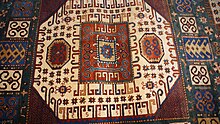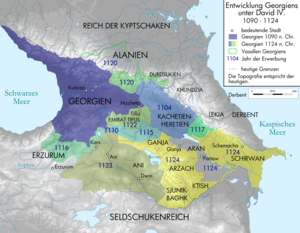Shirvan


Shirvan(fromPersian:شیروان,romanized:Shirvān;Azerbaijani:Şirvan;Tat:Şirvan)[a]is ahistorical regionin the easternCaucasus,as known in both pre-IslamicSasanianand Islamic times.[2]Today, the region is an industrially and agriculturally developed part of theRepublic of Azerbaijanthat stretches between the western shores of theCaspian Seaand theKura River,centered on theShirvan Plain.
History
[edit]Etymology
[edit]Vladimir Minorskybelieves that names such as Sharvān (Shirwān), Lāyzān and Baylaqān are Iranian names from theIranian languagesof the coast of theCaspian Sea.[3]
There are several explanations about this name:
- Shirvan or Sharvan are corrupted forms of the word "Shahrbān" (Persian:شهربان) which means "the governor". The word "Shahrban" has been used since Achaemenian Dynasty as "Xshathrapawn" (satrap) to refer to different states of the kingdom.
- Shervan in Persian means cypress tree (the same as 'sarv' in Middle Persian and in New Persian, as well as in Arabic[4]). It is also used as a male name.
- It is connected popularly toAnushirvan,theSasanianKing.[4]
However,Said Nafisipoints out that according toKhaqani's poems, where Khaqani contrasts his home town with kheyrvān (Persian:خیروان), the original and correct pronunciation of the name was Sharvān. So all etymologies relating this name to sher/shir (lion in Persian) or Anushiravan are most probably folk etymology and not based on historical facts. The form Shervān or Shirvān are from later centuries. According to the Encyclopedia of Islam, Shirwan proper comprised the easternmost spurs of the Caucasus range and the lands which sloped down from these mountains to the banks of theKur river.But its rulers strove continuously to control also the western shores of the Caspian Sea from Ḳuba (the modern town ofQuba) in the district of Maskat in the north, toBakuin the south. To the north of all these lands lay Bab al-Abwab or Derbend, and to the west, beyond the modernGoychay,the region ofShaki.In mediaeval Islamic times, and apparently in pre-Islamic Sāsānid ones also, Shirwan included the district of Layzan, which probably corresponds to modern Lahidj, often ruled as a separate fief by a collateral branch of the Yazidi Shirwan Shahs.[2]

The 19th century native historian and writerAbbasgulu Bakikhanovdefines it as: "The country of Shirvan to the east borders on the Caspian Sea, and to the south on the river Kur, which separates it from the provinces of Moghan and Armenia".[5]
Shirvanshahs
[edit]
Shirvanshah also spelled as Shīrwān Shāh or Sharwān Shāh, was the title in medieval Islamic times of a Persianized dynasty of Arabic origin.[2]They ruled the area independently or as a vassal of larger empires from 809 A.D. up to 1607 A.D. when Safavid rule became firmly established.
Safavid, Afsharid and Qajar eras
[edit]When the Shirvanshah Shah dynasty was ended by theSafavidShahTahmasp I,Shirwan formed a province of the Safavids and was usually governed by a Khan, who is often calledBeylerbey.[2]Shirvan was taken by the Ottomans in 1578; however, Safavid rule was restored by 1607.[2]In 1722, during theRusso-Persian War (1722–1723),the Khan of Quba, Husayn Ali, submitted toPeter the Greatand was accepted as his dignitary. TheTreaty of Saint Petersburg (1723)forced the Iranian king to recognise the Russian annexation. By thetreatybetween the Russian and Ottoman Empires in the year 1724, the coast of the territory ofBaku,which was occupied by the Russians, was separated from the rest of Shirvan, which was left to the Ottomans. It was only when Nader Shahdefeated the Ottomans (1735)that the Russians ceded back the coastal land and the other areas in theNorthandSouth Caucasusas conquered in 1722–1723 from Safavid Iran conform theTreaties of ReshtandGanja,and the area became part of the Afsharid Empire,[2]by which century long Iranian rule was restored.
Qajar Iran to the Azerbaijan SSR
[edit]
When theQajarshad succeeded in restoring the unity of Persia, the sons of the Khan were no more able to maintain their independence like the other Caucasian chiefs and had to choose between Russia and Persia.[2]The Khan of Shirwan, Mustafa, who had already entered into negotiations with Zubov, submitted to the Russians in 1805, who occupied the Persian cities ofDerbendand Baku the next year (1806) during theRusso-Persian War (1804–1813),but soon afterwards he made overtures to the Persians and sought help from them.[2]By theTreaty of Gulistan(12/24 October 1813) following the end of the 1804–1813 war, Persia was forced to cede its territories and regions comprisingDarband,Quba,Shirwan andBaku,while giving up all claims on them as well.[2]Nevertheless, Mustafa continued to have secret dealings with Persia. It was not until 1820 that his territory was occupied by Russian troops; the Khan fled toPersiaandShemakhawas irrevocably incorporated inRussian territory.[2]Iranian anger while being dissatisfied with losing swaths of its integral territories in the North and South Caucasus subsequently sparked theRusso-Persian War (1826–1828),which resulted in another Iranian loss, as well as the ceding of its last remaining territories in the Caucasus comprising what is nowArmenia,and southern parts of the contemporary Republic of Azerbaijan. TheTreaty of Turkmenchayof 1828 officially ratified the forced ceding of these Iranian territories to Imperial Russia, while it would also mark the official end of millennia long intertwined Iranian hegemony, rule, and influence over theCaucasusregion, including Shirvan.
People and culture
[edit]
The term Shirvani/Shirvanli is still in use in Azerbaijan to designate the people of Shirvan region, as it was historically.[6]In ancient times, the bulk of the population of Shirvan wereCaucasian-speakinggroups. Later onIranizationof this native population and subsequentTurkificationsince the Seljuq era occurred. The bulk of the population today are Turkic-speakingAzerbaijanis,although there are also smaller Caucasian-speaking and Iranian-speaking minorities.
Caucasian population
[edit]The original population were Paleo-Caucasians and spoke Caucasian languages, like theCaucasian Albanians.Today, other Daghestani Caucasian languages such asUdi,LezgianandAvarare still spoken in the region.
Iranian influence and population
[edit]Iranian penetration started since theAchaemenidera and continued in theParthianera. However it was during the Sassanid era that the influence really increased and Persian colonies were set up in the region. According to Vladimir Minorsky: "The presence of Iranian settlers inTranscaucasia,and especially in the proximity of the passes, must have played an important role in absorbing and pushing back the aboriginal inhabitants. Such names as Sharvan, Layzan, Baylaqan, etc., suggest that the Iranian immigration proceeded chiefly fromGilanand other regions on the southern coast of the Caspian. "[7]Abu al-Hasan Ali ibn al-Husayn Al-Masudi(896–956), theArabhistorian states Persian presence in Aran, Bayleqan, Darband, Shabaran, Masqat and Jorjan.[8]From the 9th century, the urban population of Shirwan increasingly spokePersian,[9][10]while the rural population seems to mostly have retained their old Caucasian languages. Up to the nineteenth century, there was still a large number ofTatpeople (who claim to be descendants of Sassanid era Persian settlers), however due to their similar culture and religion with the Turkic-speaking Azerbaijanis, this population was partly assimilated.[11]
Turkification of the region
[edit]Turkic penetration in the region started in theKhazarera, however there are no unambiguous references to settlements.[12]TheTurkificationof the region started in theSeljuqera, although the area in parallel maintained its Persian culture under the Persianized Shirvanshah until theSafavidera. From the Safavid era onwards, the Turkification of the region accelerated with new wave ofTurkomansettlements.[13]
See also
[edit]Notes
[edit]References
[edit]- ^"Chirvan",Encyclopaedia Britannica,vol. II (1st ed.), Edinburgh:Colin Macfarquhar,1771.
- ^abcdefghijBarthold & Bosworth 1997,pp. 487–488.
- ^Minorsky, Vladimir. "A History of Sharvan and Darband in the 10th–11th Centuries", Cambridge, 1958. Excerpt: Such names as Sharvan, Layzan, Baylaqan, etc., suggest that the Iranian immigration proceeded chiefly fromGilanand other regions on the southern coast of the Caspian.
- ^abDehkhoda dictionary
- ^Willem Floor, Hasan Javadi(2009), "The Heavenly Rose-Garden: A History of Shirvan & Daghestan by Abbas Qoli Aqa Bakikhanov, Mage Publishers, 2009. pg 5:" The country of Shirvan to the east borders on the Caspian Sea, and to the south on the river Kur, which separates it from the provinces of Moghan and Armenia "" Thus, present day Shirvan with Saliyan, Sheki, Baku, Qobbeh, Darband, Tabarasan and Kur and the region of the Samuriyeh and some parts of lower Ilisu is part of that and constitutes the largest and the best part of this country. "
- ^Tadeusz Swietochowski,Russia and Azerbaijan: A Borderland in Transition(New York: Columbia University Press, 1995. pg 10, 16
- ^Minorsky 1958,p.?.
- ^Al Mas'udi, Kitab al-Tanbih wa-l-Ishraf, De Goeje, M.J. (ed.), Leiden, Brill, 1894, pp. 77–8). Original Arabic from alwaraq.net: فالفرس أمة حد بلادها الجبال من الماهات وغیرها وآذربیجان إلى ما یلی بلاد أرمینیة وأران والبیلقان إلى دربند وهو الباب والأبواب والری وطبرستن والمسقط والشابران وجرجان وابرشهر، وهی نیسابور، وهراة ومرو وغیر ذلك من بلاد خراسان وسجستان وكرمان وفارس والأهواز، وما اتصل بذلك من أرض الأعاجم فی هذا الوقت وكل هذه البلاد كانت مملكة واحدة ملكها ملك واحد ولسانها واحد، إلا أنهم كانوا یتباینون فی شیء یسیر من اللغات وذلك أن اللغة إنما تكون واحدة بأن تكون حروفها التی تكتب واحدة وتألیف حروفها تألیف واحد، وإن اختلفت بعد ذلك فی سائر الأشیاء الأخر كالفهلویة والدریة والآذریة وغیرها من لغات الفرس. English: "The Persians are a people whose borders are the Mahat Mountains and Azarbaijan up to Armenia and Aran, and Bayleqan andDarband,and Ray and Tabaristan and Masqat and Shabaran and Jorjan and Abarshahr, and that is Nishabur, and Herat and Marv and other places in land ofKhorasan,and Sejistan and Kerman and Fars and Ahvaz...All these lands were once one kingdom with one sovereign and one language...although the language differed slightly. The language, however, is one, in that its letters are written the same way and used the same way in composition. There are, then, different languages such as Pahlavi, Dari, Azari, as well as other Persian languages. "
- ^История Востока. В 6 т. Т. 2. Восток в средние века.М., «Восточная литература», 2002.ISBN5-02-017711-3(History of the East. In 6 volumes. Volume 2. Moscow, publishing house of the Russian Academy of sciences «East literature»): The polyethnic population of Albania left-bank at this time is increasingly moving to the Persian language. Mainly this applies to cities of Aran and Shirvan, as begin from 9–10 centuries named two main areas in the territory of Azerbaijan. With regard to the rural population, it would seem, mostly retained for a long time, their old languages, related to modern Daghestanian family, especially Lezgin. (russian text: Пестрое в этническом плане население левобережной Албании в это время все больше переходит на персидский язык. Главным образом это относится к городам Арана и Ширвана, как стали в IX-Х вв. именоваться два главные области на территории Азербайджана. Что касается сельского населения, то оно, по-видимому, в основном сохраняло еще долгое время свои старые языки, родственные современным дагестанским, прежде всего лезгинскому.
- ^Дьяконов, Игорь Михайлович. Книга воспоминаний. Издательство "Европейский дом", Санкт-Петербург, 1995., 1995.–ISBN5-85733-042-4.cтр. 730–731Igor Diakonov.The book of memoirs.
- ^Natalia G. Volkova "Tats" in Encyclopedia of World Culture, Editor: David Publisher, New York: G.K. Hall, Prentice Hall International, 1991–1996).: "In the nineteenth century the Tats were settled in large homogeneous groups. The intensive processes of assimilation by the Turkic-speaking Azerbaijanis cut back the territory and numbers of the Tats. In 1886 they numbered more than 120,000 in Azerbaijan and 3,600 in Daghestan. According to the census of 1926 the number of Tats in Azerbaijan (despite the effect of natural increase) had dropped to 28,500, although there were also 38,300" Azerbaijanis "with Tat as their native language."
- ^An Introduction to the History of the Turkic Peoples (Peter B. Golden. Otto Harrasowitz, 1992).
- ^(Olivier Roy. "The new Central Asia", I.B. Tauris, 2007. Pg 7) "The mass of the Oghuz Turkic tribes who crossed the Amu Darya towards the west left the Iranian plateau, which remained Persian, and established themselves more to the west. Here they divided into Ottomans, who were Sunni and settled, and Turkmens, who were nomads and in part Shiite (or, rather, Alevi). The latter were to keep the name" Turkmen "for a long time: thus creating a new identity based on Shiism. These are the people today known as Azeris".
Sources
[edit]- Barthold, W. & Bosworth, C. E. (1997)."S̲h̲īrwān".InBosworth, C. E.;van Donzel, E.;Heinrichs, W. P.&Lecomte, G.(eds.).The Encyclopaedia of Islam, Second Edition.Volume IX:San–Sze.Leiden: E. J. Brill. pp. 487–488.ISBN978-90-04-10422-8.
- Bosworth, C. E. (2011)."Šervān".Encyclopædia Iranica, online edition.New York.
{{cite encyclopedia}}:CS1 maint: location missing publisher (link) - Minorsky, Vladimir(1958).A History of Sharvān and Darband in the 10th-11th Centuries.Cambridge: W. Heffer & Sons, Ltd.

